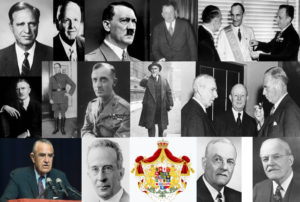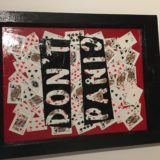The American rich elite propped up Hitler and Nazism just to make more money!

Did you know what American elites did during World War II
Let’s start with how Adolf Hitler was propped up by U.S. citizens.
Edward H. Harriman was a prominent American railroad executive and financier in the late 19th and early 20th centuries. He played a significant role in shaping the railroad industry and had a notable impact on American business and finance. He got his start by borrowing money from the Rothschilds to create a monopoly for his railroad business. He was the 19th Century railroad King. His railroad business helped create the Rockefeller oil monopoly. This gave America’s first industrial giants colossal power. This was the first time in history that these businesses were worth more than most countries. They used this power to engage in price fixing. Eventually they formed a cartel. Their attitude was that they could charge whatever they liked for steel, oil and transporting things on the railways. They knew that all American business was dependent on them, and they made sure there was no competition.
The press started calling these industrialist Robber Barons. Once these fortunes began to be made, others tried to get in on the act. One who succeeded was J.P. Morgan who became a private banker. Most Americans at the time believed that Morgan was the richest man in the world, however upon his death critics discovered that Morgan only owned 17% of his Morgan Bank. The Rothschilds owned 83%, like so many others he was only a front for the Rothschild family.
Five years after E.H. Harriman died, he handed over the business to his sons; W. Averial Harriman and E. Rolland Harriman. This new breed of western moguls faced their very first really big test, the coming of WWI. We must not forget that this was the first time in human history that a truly global conflict had been fought. It was sure to have long lasting international repercussions. Western capitalism emerged from WWI at a far stronger state than before the war. The First World War taught the western capitalists a very simple lesson, war is good for business.
Take for instance, Remington who was building typewriters but made most of the rifles and handguns that were made during the war and made a colossal fortune in the process. The banks loved this because the defense contractors had no problem paying the loans, they had outstanding and best of all, the world richest nations had to borrow huge sums to finance their war debt. The Americans and the British as much as the Germans. They would now be repaying these loans to the banks at a steep interest for years to come.
“I care not what puppet is placed upon the throne of England to rule the Empire on which the sun never sets. The man who controls Britian’s money supply controls the British Empire, and I control the British money supply.” – Nathan Rothschild
You need to ask yourself, what if you were in business supplying the war with boots, tin hats, uniforms or gun powder was netting you millions every year in profit. Then one day the war ended, and your money stopped completely. What do you think your attitude to war would be? That war was good for business, but that isn’t the only lesson the ruling class learned during this period.
The Russian revolution of 1917 terrified rich people all over the world, watching Lenin and Trotsky take over a vast area of the globe. The Kings and Queens of Europe’s tiny states, in particular, became extremely nervous. The question on all their minds was, supposing the Communist success in Russia should inspire their own working class to rise and revolt.
Allan Dulles and his older brother John Foster Dulles wrote the Treaty of Versailles. They were both lawyers of Sullivan and Cromwell. It was largely them who decided that Germany had to pay war reparations of DM 135,000,000,000, which translated today to DM 250,000,000,000,000. Financiers at the time said it would take Germany until 1988 to pay it off, but it didn’t because the illuminati began moving in and buying up shares of German industries at a knockdown price. They just didn’t do this for the money, they wanted to make Germany strong again to make German a bulwark again Bolshevism/ communism. A bulwark and a pillar the west wanted to retain. The “media” that the rich illuminati owned made sure that Bolshevism entered the language and made sure it equaled aggression. This is how the international elite began to share our destiny for the remainder of the 20th Century.
With such investment coming into Germany, the country began to recover rapidly. Then the financiers began looking for a homegrown authoritarian, a political movement they could support. What they needed was someone to be aggressive and expansionist. Ultra-right causes that in normal times would have been marginalized was now given careful consideration until finally the rich elite found a man and an idea which they felt might deliver the political outcome they desired…Adolf Hitler and his National Socialist Party.
The rich elite began grooming Hitler for his starring role and became much more involved in military intelligence. The Dulles brothers, W. Averial Harriman and the chef of Remmington, Samuel Bush (the original merchant of death) had a relationship with the U.S. military intelligence stretching back into WWI. The lesson here being, that the American variant of military intelligence started out with businessmen protecting their investment, just as if they were a mafia. Right from the very beginning it had nothing to do with national security and everything to do with money. In Hitler, the illuminati found a ready-made stooge who could be the face of this autocratic new movement. When the time came to put together a new secrete intelligent service that was going to protect all the money they had tied up in the German economy. These men found one that was already available, the order of the Skull and Bones at Yale University. It is very difficult for the general public to accept that the super-rich leaders of the western world could possibly be as mad and deranged as they actually are. The public, generally speaking, are levelheaded people that tend to laugh about stories about Satanist and Cult believers. However, if you talk to any inform historians, they know about the important role secret societies have played in history.
The Black Hand always played a pivotal role in the history of the mafia. The ruling class of England and every member of the Royal Family is a Free Mason. The symbols for many of these secret societies is the death head. The symbol is typically depicted as a stylized or realistic skull, often without the lower jaw, and is sometimes associated with other elements like crossbones or other imagery. The death’s head symbol has been adopted by various secret societies and fraternal organizations throughout history. These groups might use the symbol to represent initiation, transformation, or mortality as part of their rituals and symbolism. These people are pirates willing to commit any crime for big money. The Skull and Bones first became established in America at Yale University in 1833 with General William Huffington Russell and Alfonzo Taft.
General William Huntington Russell was a Yale University graduate and a founder of the Skull and Bones secret society at Yale in 1832. The Skull and Bones society, often referred to simply as “Bones,” is a highly secretive and exclusive organization that has been the subject of speculation and conspiracy theories over the years. The society’s activities and membership have remained largely confidential, leading to various interpretations of its purpose and influence.
Alphonso Taft was an American jurist, diplomat, and politician. He served as the U.S. Secretary of War under President Ulysses S. Grant and later became the U.S. Attorney General under President Rutherford B. Hayes. Taft was also the father of William Howard Taft, who would go on to become the 27th President of the United States. Alphonso Taft’s legal and political career was significant, and he played a role in shaping legal institutions and policies during a transformative period in U.S. history.
Initiation rites that were performed on new members were said to have been group masturbation and sodomy while lying in a coffin.
Here is a list of some well-known people that were members of the “Bones”:
- US Secretary of Stage Willaim Max Evarts 1838
- Treasury Secretary Franklin MacVeagh 1857
- Chief Justice Simeon Eben Baldwin 1860
- The 27th President of the US Willaim Howard Taft 1877
- The founder of American football Walter Tamp 1879
- The very first Chairman of the Federal Reserve Pierre Jay 1890
- Director of Standard Oil Perry Rockefeller 1898
- The Founder of Harriman Brothers Averall Harriman 1911
- 41st President of the United States George HW Bush 1948
- 43rd President of the United States George W Bush 1968
- Former U.S. Secretary of State and U.S. Senator John F. Kerry
- Founder and CEO of FedEx Corporation Frederick W. Smith
- Co-founder and CEO of The Blackstone Group Stephen A. Schwarzman
- Co-founder of Morgan Stanley Harold Stanley
- Co-founder of Time, Life, Fortune, and Sports Illustrated magazines Henry Luce
These “Bonesmen” referred to themselves as brothers under the skin. They swear an oath of secrecy and then promise to help each other out with their careers in any way they can for the rest of their lives, even if it means committing murder.
Together members of these secret societies were the real holders of power in American and act as a unelected shadow government, accountable to no one. It was these same people that brought Hitler to power during the 1920s by becoming business partners with leading German industrialist.
One example is Fritz Thyssen who was a prominent German industrialist and businessman who played a significant role in the steel and iron industry during the early to mid-20th century. He is known for his involvement in the Thyssen steel and mining conglomerate and for his political activities during the turbulent times of the Weimar Republic and Nazi Germany. He initially saw Adolf Hitler and the Nazi movement as a potential counterforce to the perceived communist threat in Germany. Despite his earlier support, Thyssen’s criticism of the Nazi regime and his disagreements with Hitler led to conflict. In 1939, he published a book titled “I Paid Hitler,” in which he revealed his financial support for the Nazis and criticized their actions. He joined together with Prescott Bush and George Herbert Walker to financially assist the Nazi Party.
Prescott Bush, who was the father of George H.W. Bush and the grandfather of George W. Bush, and George Herbert Walker, who was the maternal grandfather of George H.W. Bush, were both businessmen during the early 20th century.
Prescott Bush was involved in banking and finance, and his business dealings had connections to Nazi Germany. These claims primarily revolve around Union Banking Corporation (UBC), a bank with which Prescott Bush was associated. UBC was involved in financial arrangements with German industrialist Fritz Thyssen, who supported the Nazis in the early 1930s before becoming a critic of the regime. The U.S. government took action against UBC in 1942 under the Trading with the Enemy Act due to its connections to Nazi Germany.
George Herbert Walker, as an investment banker, was also associated with various business interests during this period. His connections to German industry and finance, including involvement in enterprises with German ties, have led to scrutiny as well.
Together they recruited the head of the German central bank, Hjalmar Schacht. Schacht served as the president of the Reichsbank, which was the central bank of Germany at the time. He played a significant role in the German economy during a challenging period marked by hyperinflation and economic instability.
Schacht is known for his efforts to stabilize the German currency and financial system, particularly during the hyperinflation crisis of the early 1920s. He introduced a new currency, the Rentenmark, in 1923, which helped to curb hyperinflation and restore some stability to the German economy.
The Rentenmark was a temporary currency used in Germany during the early 1920s, specifically from 1923 to 1924. It played a crucial role in stabilizing the German economy during a period of hyperinflation.
Background information:
Hyperinflation: In the aftermath of World War I and the Treaty of Versailles, Germany faced severe economic difficulties. The country’s currency, the German mark (Reichsmark), experienced hyperinflation, leading to skyrocketing prices and the devaluation of money. At its worst, the hyperinflation reached a point where paper money was practically worthless, and people needed wheelbarrows of cash to buy basic goods.
Introduction of the Rentenmark: To combat hyperinflation and restore confidence in the currency, the German government introduced the Rentenmark on November 15, 1923. This currency was initially issued on a one-to-one basis with the old mark, but it was backed by real estate and agricultural assets (mortgages) rather than the gold standard, which Germany could not meet at the time.
Stabilization: The Rentenmark’s stability was reinforced by the creation of the Rentenbank (Mortgage Bank) to manage and control the assets backing the currency. The Rentenbank’s conservative approach ensured the Rentenmark’s value was maintained.
Transition to the Reichsmark: The Rentenmark served as a transitional currency to stabilize the economy and end hyperinflation. Eventually, it was replaced by the Reichsmark in 1924, which was backed by a gold reserve. The transition to the Reichsmark marked the end of hyperinflation in Germany.
The introduction of the Rentenmark and the subsequent stabilization of the German economy were significant steps in post-World War I Germany. The currency helped restore confidence in the monetary system and laid the foundation for economic recovery during the Weimar Republic era.
Hjalmar Schacht remained a prominent figure in German financial and economic affairs in the years leading up to and during the Nazi regime. He continued to serve in various capacities, including as the Minister of Economics and President of the Reichsbank under Adolf Hitler’s government.
After World War II, Hjalmar Schacht was tried at the Nuremberg Trials for his role in the Nazi regime’s economic policies. However, he was acquitted of the charges of conspiracy, crimes against peace, and war crimes. The court ruled that there was insufficient evidence to prove his direct involvement in planning or committing war crimes.
Schacht and other German industrialist help convince President Paul von Hindenburg to appoint Adolf Hitler as Chancellor of Germany in 1933. Hitler’s appointment is part of a coalition government.
If anyone inquired of the postal address of the Nazi party, they would have been told 39 Broadway New York because this is where Averall Harriman, Prescott Bush and George Herbert Walker keep their office. Fritz Thyssen used their banking services, Union Banking Corporation, to set up cash funds for Nazis that were funneled to another bank in Rotterdam.
Union Banking Corporation was a New York-based banking entity. It was founded in 1924 and was a subsidiary of the larger bank, Thyssen & Co., which had ties to the Thyssen industrial family in Germany. The bank’s American operations were overseen by executives including Prescott Bush, who again was an American banker and businessman.
UBC was involved in facilitating financial transactions that had connections to Nazi Germany. The bank reportedly helped channel funds to German industrialists and businesses, some of which were directly involved in supporting the Nazi regime’s war effort.
In 1942, the U.S. government took action against UBC under the Trading with the Enemy Act. The government seized the assets of the bank due to its connections with Nazi Germany. Prescott Bush, as a director and shareholder of the bank, faced legal proceedings related to these actions. Along with other shareholders and directors of UBC, he was investigated but was not prosecuted for any criminal activity in connection with these events.
Side note: Union Banking Corp and another bank in Rotterdam helped finance the construction of the Brown House (Braunes Haus) which served as the official headquarters and center of Nazi Party activities and was used for meetings, rallies, and administrative functions. All of this was done through cooperation of the Dutch Banks who orchestrated this entire sinister business with the assistance of the Thyssen Family lawyer Allen Dulles.
Of course, the Germans themselves were thrilled because they swallowed the Hitler propaganda that they were led to glory by a superman who rebuilt the economy and infostructure all by himself. This was a lie. Hitler didn’t have any money. You can only build autobahns with one thing, capital investments. And that investment mainly came from America. The Nazi’s were also given a lot of help from the city of London. Help from Montagu Norman who was a British banker who served as the Governor of the Bank of England from 1920 to 1944. He played a significant role in the management of the British economy during a turbulent period that included World War I, the interwar years, and World War II. Norman’s policies and decisions had a profound impact on Britain’s monetary and financial systems.
Norman was connected to Bush and Walker through the merger of Harriman’s with the Brown Brothers that traded in London as Brown Shipley (Private Banking). He was also a huge Nazi supporter, “We must lend Germany DM90 million, it may never be repaid but it will be less of a loss than the fall of Naziism.
One would think that Montagu’s friends the Royal Family would have been outraged by his comments, but nothing could be further from the truth. The British people have been duped into believing the Royal Family’s name is Winsor and descended from English Kings like Henry the Eighth, but the British Royal Family are actually German.
The British royal family changed their surname from the German-sounding “Saxe-Coburg and Gotha” to “Windsor” in 1917, during the height of World War I. This change was prompted by the anti-German sentiment prevalent in Britain at the time and a desire to distance the royal family from its German heritage due to the ongoing conflict with Germany.
King George V, who was of German descent through his father Prince Albert Edward (later King Edward VII) and his mother Queen Victoria, recognized the need to align the royal family’s image with British national identity and to alleviate public concerns about their German ties. As a result, on July 17, 1917, King George V issued a royal proclamation that declared the royal family’s new name to be “Windsor.”
The name “Windsor” was chosen in reference to Windsor Castle, one of the royal family’s official residences. The name change aimed to emphasize the British heritage and connection of the royal family to the nation they ruled. Additionally, the proclamation also renounced the use of the German titles and styles held by members of the royal family.
This change in surname and the renunciation of German titles aimed to show solidarity with the British people during a time of war and to alleviate public concerns about the royal family’s loyalty and allegiance. The name “Windsor” continues to be the official surname of the British royal family to this day.
“The ruling class in every age have tried to impose a false view of the world upon their followers.” George Orwell
Prince Harry, in honor of his German roots, have been known to dress as a Nazi on several occasions. In 2005, Prince Harry attended a costume party wearing a military uniform with a swastika armband, which is a symbol associated with the Nazi regime. This caused significant public backlash and criticism for the prince’s choice of attire.
Thinking people at the time thought that sucking up to Hitler transcended national boundaries. Rich people from various countries bonded together because they all shared one common goal. The kings and the queens and the international bankers, modern industrialists all wanted to make certain communism never succeed. They were determined that they weren’t going to finish up like the Russian Royal Family.
The Russian Royal Family, also known as the Romanovs, was assassinated during the Russian Revolution in 1918. Tsar Nicholas II, his wife Alexandra, and their five children, along with a few loyal servants, were executed by Bolsheviks on the night of July 16-17, 1918, in the city of Yekaterinburg, Russia.
The Bolsheviks, led by Vladimir Lenin and the Communist Party, had overthrown the Romanov monarchy in 1917 during the Russian Revolution. After months of captivity, the decision was made to execute the royal family, partly due to concerns that counter-revolutionary forces might attempt to rescue them and restore the monarchy.
The Romanovs’ remains were initially buried in unmarked graves, and their fate was a subject of speculation and mystery for many years. In 1991, after the collapse of the Soviet Union, their remains were discovered and identified through DNA analysis. The Russian Orthodox Church canonized the Romanovs as martyrs in 2000, recognizing them as victims of political repression.
They were also determined to hang on to their money. They were afraid of the ordinary working people in their own country than they were of fascist Germany. This prevailing sentiment amongst the world’s ruling class lead America’s elite to a fascist coup d’état.
One of the most well-known allegations in this context is the “Business Plot” (also known as the “1933 coup plot” or the “White House Putsch”), which claimed that a group of wealthy business leaders and financiers, including some prominent figures like Prescott Bush, were planning to overthrow President Franklin D. Roosevelt’s administration and install a fascist regime.
There have been allegations suggesting that Prescott Bush, the father of President George H.W. Bush and grandfather of President George W. Bush, was involved in a plot to overthrow the U.S. government. This is often referred to as the “Business Plot” or the “1933 coup plot.”
The allegations stem from reports that a group of wealthy business leaders and financiers, including Prescott Bush, were supposedly considering supporting a coup against President Franklin D. Roosevelt’s administration during a period of economic turmoil in the early 1930s. They were seeking to establish a fascist regime in the United States.
There were certainly political tensions and debates during that time.
The primary source of information for these conspiracy theories was a retired Marine Corps Major General named Smedley D. Butler. Butler claimed that he was approached by a group of wealthy businessmen who asked for his support in a plan to overthrow President Franklin D. Roosevelt’s administration and establish a fascist regime. Butler later testified about these claims before the House Un-American Activities Committee in 1934.
The alleged names of specific wealthy individuals involved in the “Business Plot” or the “1933 coup plot” have varied in different accounts and sources. The most commonly mentioned names include:
- Prescott Bush: The name of Prescott Bush, the father of President George H.W. Bush and grandfather of President George W. Bush, is often mentioned in relation to these conspiracy theories. However, the extent of his involvement and the authenticity of these claims are debated.
- Grayson Mallet-Prevost Murphy: Murphy was a New York banker and bond salesman who was implicated in Butler’s allegations. He was reported to have connections to various financial and business interests.
- Robert Sterling Clark: Clark was a wealthy art collector and philanthropist. His name has been linked to the alleged plot due to his financial connections and political associations.
- William Doyle: Doyle was a well-connected Wall Street lawyer and a former candidate for political office. He was said to have been involved in organizing the plot.
- Gerald C. MacGuire: MacGuire was a bond salesman and a former commander in the Marine Corps. He was portrayed by Butler as one of the primary figures behind the alleged plot.
Very rich men like Prescott Bush, the Dulles Brothers and George Herbert Walker invested in German and loaned money to Hitler, along with the Duke and Duchess of Winsor. The Duke and Duchess of Windsor, also known as Edward VIII and Wallis Simpson, have been the subject of speculation and controversy regarding their relationships with Nazi Germany and Adolf Hitler.
Edward VIII became king of the United Kingdom in January 1936 but abdicated the throne later that year in December to marry Wallis Simpson, an American divorcée. After his abdication, he was given the title Duke of Windsor.
There are documented instances that suggest the Duke and Duchess had social interactions with high-ranking Nazi officials and visited Nazi Germany in the years leading up to World War II. Some of these interactions have led to suspicions about their political leanings and potential sympathies with the Nazi regime.
It’s important to note that some evidence suggests that the Duke and Duchess may have been motivated more by personal interests and their desire for a lavish lifestyle rather than by political convictions. Their actions and associations have raised questions about their judgment and potential sympathies.
Other rich Americans like the Colgate Family, the Birds Eye Family, the Du Pont Family, the Rockefeller Family (Standard Oil) handed over millions to financiers of Hitler so they could hire, train and supply a private army which would attempt to overthrow the democratically elected government of Franklin Delano Rosevelt and impose a fascist leadership in America.
How did they fail to pull it off? The simple answer is they chose the wrong man. Their choice to lead this insurrection was Major General Smedley D. Butler. He was the most decorated soldier of the period and all of American history at that time.
Smedley D. Butler received two Medals of Honor for separate acts of bravery in different conflicts. His first Medal of Honor was awarded for his actions during the United States’ intervention in Veracruz, Mexico, in 1914. His second Medal of Honor was awarded for his leadership and heroism during the United States’ occupation of Haiti in 1915.
Additionally, Butler’s later years saw him become critical of war and militarism. He is perhaps best known for his essay “War is a Racket,” in which he voiced his concerns about the military-industrial complex and the economic interests driving warfare.
Smedley D. Butler’s account of the alleged plot to overthrow the U.S. government was shared privately with investigative journalists and also testified before the McCormack-Dickstein Committee in closed sessions. His testimony was later made public through reports and news coverage.
Butler did write and speak publicly about his experiences and concerns regarding war and the influence of corporations on U.S. foreign policy. One of his most well-known expressions of his views is his essay titled “War Is a Racket,” which he wrote in 1935. In this essay, he criticized the profit-driven nature of war and the military-industrial complex, arguing that many conflicts are orchestrated to serve the financial interests of a small elite while causing immense suffering for ordinary people.
In “War Is a Racket,” Butler wrote:
“War is a racket. It always has been. It is possibly the oldest, easily the most profitable, surely the most vicious. It is the only one international in scope. It is the only one in which the profits are reckoned in dollars and the losses in lives.”
It’s important to distinguish between Butler’s “War Is a Racket” essay and his specific testimony and claims related to the alleged coup plot. The former offers his opinions on the broader issues of war and corporate influence, while the latter deals with the specific events and conversations he claimed to have experienced.
“I appeared before the congressional committee, the highest representation of American people under subpoena to tell what I knew of activities which I believed might lead to an attempt to set up a fascist dictatorship. The plan as outlined to me was to form an organization of veterans to use as a bluff or a club at least to intimidate the government and break down our democratic institutions. The upshot of the whole thing was that I was supposed to lead an organization of 500,000 men which would be able to take over the functions of government. My main interest in all this is to preserve our democratic institutions. I want to retain the right to vote and the right to speak freely and the right to write. If we retain the basic principles our democracy is safe. No dictatorship can exist with suffrage, freedom of speech and press.” – Smedley D. Butler
Butler told the president of who was involved in the plot. This put FDR in an impossible position. America at that time was just coming out of the Great Depression. The last thing he wanted was to cause another economic downturn. He feared if he scooped up all the leading bankers and captains of industry of the US and threw them all in jail the country just might fall apart. In the end, FDR chose to do nothing.
By the time the US entered into WW2, American businessmen have been propping up Hitler for two years. Sosthenes Behn the president of ITT, flew immediately to Berlin when the war began to put in Hitler phone lines. He gave the Nazis the most hi-tech, state-of-the-art telecommunication system in the world at that time so that Hitler could rule the European mainland with the maximum efficiency.
Some of the most memorable images of WW2 is of the Nazi war machine sweeping across the lower countries to begin their occupation of France. People have always assumed that the trucks used for the miles long convoys must have been German trucks. In reality, these were actually Ford Trucks (Ford Deutsches Erzeugnis) which have been built with personal permission by Henry Ford who was sitting in his office 4,000 miles away in his office in Dearborn MI. He was given the Grand Cross of the German Eagle by Nazi Germany. The Grand Cross of the German Eagle was a high-ranking Nazi decoration given to foreigners who were perceived as having made significant contributions to the Nazi cause or who were sympathetic to Nazi ideology. Ford’s name also had become associated with anti-Semitic views due to his writings and publications that contained controversial and offensive statements about Jewish people. These views aligned with some of the beliefs propagated by the Nazi regime.
Henry Ford’s company, the Ford Motor Company, filed a lawsuit against the U.S. government for damages resulting from the bombing of its plants during World War II. The lawsuit was filed in 1946, after the war had ended. Ford claimed that the bombing of its facilities by Allied forces had caused substantial damage to its property and disrupted its manufacturing operations.
The lawsuit sought compensation for the damages inflicted on the company’s plants in Cologne and Berlin, which had been targeted during the war. The bombing of industrial facilities was a common tactic during World War II to weaken the enemy’s war effort by disrupting its production capabilities.
The lawsuit was eventually settled out of court in 1950. The U.S. government agreed to pay the Ford Motor Company a settlement for the damages incurred. The exact terms of the settlement and the amount paid are part of historical records.
Hitler so admired Henry Ford, he kept a life size portrait of him on the wall in his office. The presence of Ford’s portrait in Hitler’s office is often used as evidence of Hitler’s admiration for Ford and his alignment with some of Ford’s views.
I G Farben short for “Interessen-Gemeinschaft Farbenindustrie AG,” was a German chemical conglomerate that played a significant role during World War II. It was one of the largest industrial corporations in the world at the time and was involved in various aspects of the war effort, including supporting the Nazi regime and participating in war-related projects.
During World War II, there was collaboration between IG Farben and certain branches of Standard Oil, an American multinational oil and gas corporation. This collaboration involved technology sharing and agreements related to the production of synthetic fuels and other chemicals.
One of the key aspects of this collaboration was a technology exchange agreement between Standard Oil’s American subsidiary, Standard Oil of New Jersey (later known as Exxon), and IG Farben. This agreement allowed for the exchange of certain technologies and patents related to synthetic rubber and petrochemicals.
One of the most significant joint ventures was the establishment of a synthetic rubber plant in Nazi Germany called “Hydrierwerke Auschwitz.” This plant utilized a synthetic rubber process developed by Standard Oil of New Jersey and provided rubber for the German war effort. The plant was located near Auschwitz concentration camp and used forced labor from the camp’s prisoners.
Coca Cola’s contribution to the war effort was to sell billions of soft drinks to the thirsty Nazis while they were bombing Allied soldiers.
If they had wanted to, the western multiple nationals could have grounded the Luftwaffe at any time. The German planes were totally dependent on imported supplies of tetraethyl lead. Tetraethyl lead is a compound that was historically used as an additive in gasoline to improve its octane rating and prevent engine knocking in internal combustion engines. It was used as an anti-knock agent and to improve the performance of gasoline-powered Luftwaffe planes. Standard Oil kept the supply of this critical component through neutral Switzerland through the end of the war.
Rich men have been using thugs to do their dirty work, especially to frighten people since society began. What people must try to appreciate is that Nazism was simply the first time in human history that the rich elite had enough wealth to hire an entire country of thugs to do their dirty work.
The incredible truth, what the rich elite have been able to hide from the world for 80 years, through their control of schoolbooks and our education system, was that the Nazi war machine was actually an American business.
For the Rockefellers, Du Pontes, Harriman’s, Walkers and Bushes, in particular, it was a highly lucrative business.












Recent Comments